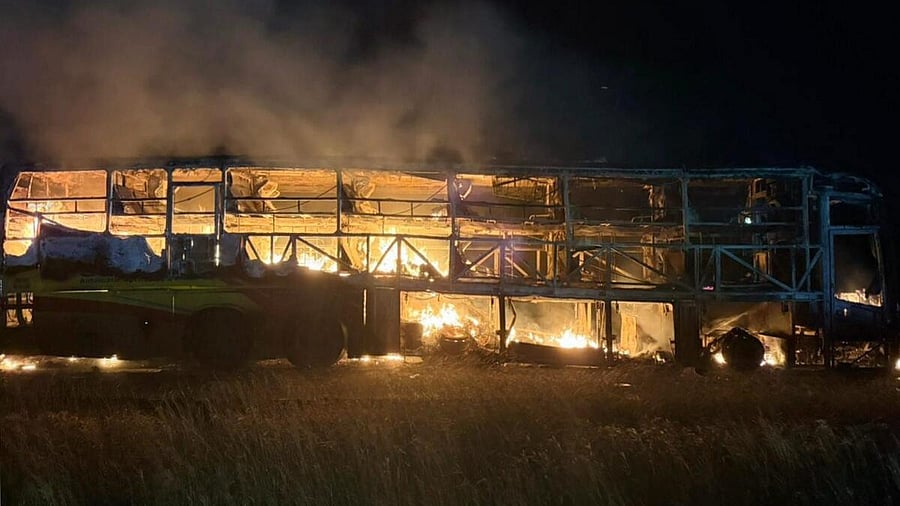
A Hyderabad-bound private bus after it caught fire following a collision with a two-wheeler, near Chinnatekur in Kurnool district
Credit: PTI Photo
The horrific fire that engulfed a private sleeper bus from Hyderabad to Bengaluru in the early hours of Sunday is a grim reminder of how fragile passenger safety has become on Indian highways. The bus caught fire after it hit a two-wheeler that had earlier crashed into a road divider and was lying on the carriageway. The motorcyclist, reportedly inebriated, died on the spot. At least 19 people were charred to death, and several others were injured after the bus burst into flames near Kurnool. This is not an isolated tragedy. Earlier this month, 26 people were killed when a bus caught fire in Rajasthan. Investigators found that a short circuit in the air-conditioning system had triggered the inferno. In 2023, a similar accident in Maharashtra claimed at least 25 lives, while another in Madhya Pradesh that same year left 13 passengers dead. Each of these cases revealed the same grim pattern of neglect: faulty wiring, combustible cargo, and the absence of enforceable safety standards.
In the Kurnool tragedy, around 400 smartphones were reportedly being transported in the bus’s luggage compartment, which may have aggravated the explosion and the spread of the fire. Yet the deeper malaise lies in how sleeper buses have been turned into death traps. Operators routinely modify these vehicles to accommodate additional berths, often at the expense of emergency exits, and habitually disregard basic fire-safety regulations. Often, buses carry prohibited goods such as LPG cylinders, paint cans, or even fireworks, in blatant violation of transport laws. The so-called “emergency door”, painted in bold letters across the rear windshield, is a cruel illusion. In most vehicles, it is either permanently sealed or impossible to break open. Why? Because every extra seat translates into additional revenue. When the accident occurs at night – as it often does – disoriented and sleeping passengers stand no chance of survival.
This tragedy must serve as an eye-opener for every state transport authority, including Karnataka’s. Every passenger bus – public or private – must prominently display a list of prohibited items, and random checks should be conducted both by operators and the transport department to ensure compliance. Those found violating safety norms should face severe penalties. Fitness certificates must not be routine paperwork but proof that brakes, electrical systems, and other parts are in working order. Fire extinguishers, alarms, and smoke detectors should be compulsory, and emergency exits must be non-negotiable. It should not take another night of flames and screams for governments to act. Every journey on the roads must be a guarantee of safety, not a roll of the dice with death.
